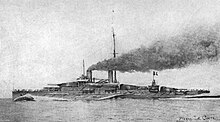Lyon-class battleship
 Plan and left elevation drawing of the Lyon class as depicted in the Journal of United States Artillery
| |
| Class overview | |
|---|---|
| Name | Lyon |
| Builders | France |
| Operators | |
| Preceded by | Normandie class |
| Succeeded by | Dunkerque class |
| Planned | 4 |
| Completed | 0 |
| Cancelled | 4 |
| General characteristics | |
| Type | Battleship |
| Displacement | 29,600 t (29,133 long tons) |
| Length |
|
| Beam | 29 m (95 ft 2 in) |
| Draft | 8.65 to 9.2 m (28 ft 5 in to 30 ft 2 in) |
| Installed power | 40,000 CV (39,000 shp ) |
| Propulsion |
|
| Speed | 21 knots (39 km/h; 24 mph) |
| Armament |
|
| Armor |
|
The Lyon class was a set of
Design

The French Navy began a
One of the main considerations for the new design was the armament to be carried. The French were aware that the latest British battleships—the Queen Elizabeth class—were to be armed with 38 cm (15 in) guns, prompting significant consideration of matching this caliber for the Lyon design. The design staff prepared four variants, two armed with the standard French 34 cm gun in twin or quadruple gun turrets, and two armed with 38 cm guns in twin turrets. The designers also briefly considered a ship armed with twenty 30.5 cm (12 in) guns in quadruple turrets, but the decrease in gun caliber was deemed to be a step in the wrong direction and it was quickly rejected. At the time, the French Navy believed that at the expected battle ranges in the Mediterranean, the 34 cm gun was effective and so the larger 38 cm gun was not necessary.[6] The design staff determined the 38 cm gun would take too long to design, so the proposals that incorporated these weapons were rejected and officials chose between the two 34 cm proposals. The first proposal, which mounted fourteen guns, was a 27,500-metric-ton (27,066-long-ton) ship 185 meters (607 ft) long. On 24 November 1913, the design staff instead chose the slightly larger second design, armed with sixteen guns in four quadruple turrets, but the specific 34 cm gun to be used to arm the ships was still an open question.[4]
The first proposal by the Directorate of Artillery (Direction de l'artillerie) was for the existing 45-caliber[a] gun used by the Bretagne and Normandie-class ships to be modified to use a slightly longer shell that weighed 590 kg (1,300 lb), 50 kg (110 lb) more than the existing shell, and was optimized for underwater performance. The second proposal was for a 50-caliber gun that fired a larger 630 kg (1,390 lb) shell. Accommodating the extra volume and weight of the longer gun was estimated to increase the displacement of the design to 31,000–32,000 t (31,000–31,000 long tons) and to increase the cost from 87 million francs to 93–96 million. The first option was ultimately selected in February 1914.[7] The first two ships, Lyon and Lille, were scheduled to be ordered on 1 January 1915, and Duquesne and Tourville would have followed on 1 April.[3]
The run-up to and beginning of World War I led to the end of the Lyon class. The French government mobilized its reserve forces in July, a month before the conflict, and thereby stripped its shipyards of many of the specialized tradesmen required for constructing the ships. The French also redirected their industrial capacity to weapons and munition orders from the army. In light of such constraints, the navy decided that only those ships that could be completed quickly would be worked upon, such as the Bretagnes.[4][8]
Ships
| Ship | Builder[3] |
|---|---|
| Lyon | St Nazaire
|
| Duquesne | Arsenal de Brest, Brest
|
| Lille | La Seyne
|
| Tourville | Arsenal de Lorient, Lorient
|
Characteristics
The ships would have been 190 m (623 ft 4 in)
The
The
The ships would have been protected with a modified version of the armor layout of the earlier Normandie class. The primary alteration was that the upper
Notes
Footnotes
- ^ In this case, "caliber" refers to the length of the gun expressed in terms of the barrel diameter; a 45-caliber gun would be 45 times long as it is in diameter.
Citations
- ^ Gardiner & Gray, pp. 190–191
- ^ Jordan & Caresse, p. 162
- ^ a b c d e Gardiner & Gray, p. 199
- ^ a b c O'Brien, p. 47
- ^ Wilmott, p. 143
- ^ a b Jordan & Caresse, p. 204
- ^ a b c Jordan & Caresse, p. 206
- ^ Jordan & Caresse, p. 189
- ^ Jordan & Caresse, pp. 204–205
- ^ Barnett, p. 377
- ^ Friedman, p. 209
- ^ Friedman, pp. 204, 208
- ^ Friedman, p. 225
- ^ Jordan & Caresse, pp. 204–207
References
- Barnett, M. K. (1915). "The New French Battleship "Tourville"". Journal of the United States Artillery. 44 (2). School Board of the Coast Artillery School: 377–379. OCLC 225526618. Retrieved 4 November 2018.
- ISBN 978-1-84832-100-7.
- Gardiner, Robert & Gray, Randal, eds. (1985). Conway's All the World's Fighting Ships 1906–1921. Annapolis: Naval Institute Press. ISBN 978-0-87021-907-8.
- Jordan, John & Caresse, Philippe (2017). French Battleships of World War One. Annapolis: Naval Institute Press. ISBN 978-1-59114-639-1.
- O'Brien, Phillips Payson (2001). Technology and Naval Combat in the Twentieth Century and Beyond. London: Frank Cass. ISBN 978-0714651255.
- Willmott, H. P., ed. (2009). The Last Century of Sea Power (Volume 1, From Port Arthur to Chanak, 1894–1922). Bloomington: Indiana University Press. ISBN 978-0-2533-5214-9.
